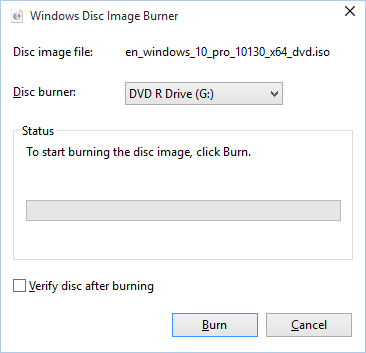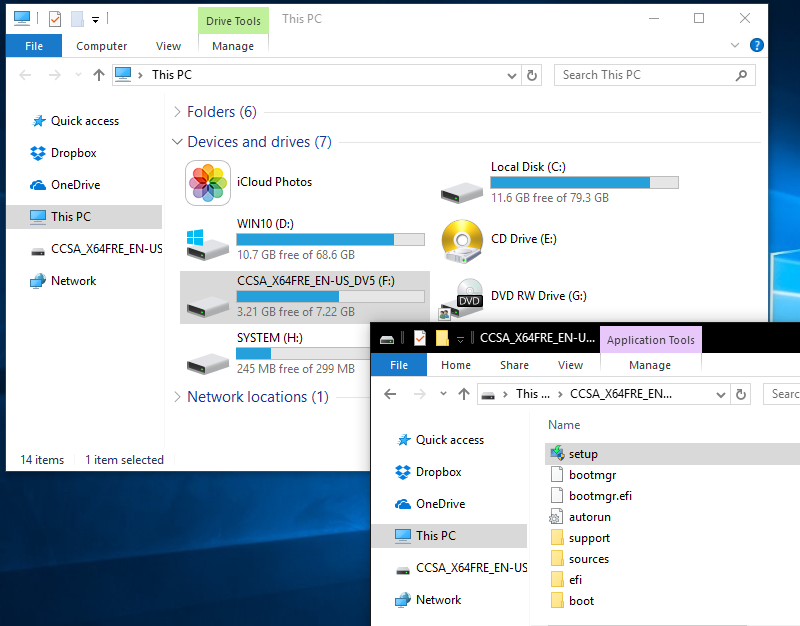NOTE: These instructions reference Windows 10, but they work just as well if you want to create a bootable copy of Windows 7 or Windows 8.
Technical Level : Basic
Summary
If you performing a new installation of Windows 10, you might need to prepare bootable install media. The Media you choose to install from will depend on certain factors, such as the Boot Scheme used by your computer (BIOS, UEFI) in addition to the storage
device (hard disk partitioning layout). Examples of partitioning layout include MBR (BIOS) and GPT (UEFI). In this article, we show you several ways to create a bootable copy of Windows 10 from an ISO file. An ISO file is a digital replica of a virtual disc,
which users will have to make bootable on a blank DVD, USB thumb drive or SD card.
Details
Before we begin, you need to have a copy of Windows 10 ISO file. See the following article for instructions how to download a ISO image for Windows 10 using the Media Creation Tool:
How to download official Windows 10 ISO files
NOTE: Microsoft no longer provides direct access to Windows 10 ISO images from the Microsoft Techbench website for computers running Windows 7, Windows 8.0, Windows 8.1 and Windows 10. You can still download the ISO image from computers running earlier versions of Windows such as Windows XP, Windows Vista or alternative operating systems such as Linux or macOS.
Learn more: Microsoft Removes Access to Windows 10 ISO for Windows 7 or Later
Resources: Download Windows 10 ISO Files Directly Using Your Web Browser
After downloading the Windows 10 ISO, you need prepare it, this is especially important for Windows 7 and earlier versions of Windows.
You can use the built in Disc Image burning tool or Microsoft .iso to USB/DVD tool to create a bootable DVD or USB (requires a blank DVD) or Rufus, a third party program that can create a bootable USB flash stick (requires at least 8 GBs).
After downloading the .ISO file, right click it and click Burn disc image
Insert a blank DVD
Click Burn
Windows 8/8.1 users can mount the .ISO file then start the upgrade automatically. Learn more here
Important:
If you are creating a bootable USB thumb drive, make sure the thumb drive is first formatted as FAT32.
Connect the thumb drive
Open Computer
Right click thumbdrive
Click Format
Make sure FAT32 is selected as the file system.
For UEFI based systems
If your computer is UEFI based, these are normally systems that come pre-loaded with Windows 8 or later, you will need to prepare the ISO file for such a configuration or you will receive an error message during setup. The thumb drive needs to be formatted as FAT32. If you are installing on a hard disks that is 4 TBs or more in size, you need to format the disk using the GPT partitioning scheme. Rufus ensures your copy of Windows 10 is properly prepared to support it.
You can download Rufus, for free.
After downloading Rufus, connect your thumb drive, launch Rufus application, click in the Device list box then choose your thumb drive.
Click in the list box then choose your partition scheme. If you select the ISO, Rufus will automatically select the appropriate options for you. Next, click in the File system list box, then choose FAT32. If your thumb drive is larger than 32 GBs, choose exFAT.
Leave the default Cluster size then enter a label for your thumb drive.
Click the choose disk image icon, browse to where the ISO file is located, select it then click Open.
Click Start to copy the files to the thumb drive.
If you have any files on the thumb drive, they will be deleted.
Wait while the files are copied to your thumb drive.
Close when complete
Open File Explorer, then launch setup to begin the installation.
If you are performing a clean install see instructions how to configure your BIOS or UEFI firmware:
BIOS/UEFI Setup Guide: Boot from a CD, DVD, USB Drive or SD Card











